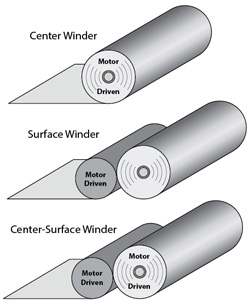by Joe Connelly , Product Manager - Winding and Slitting

Selecting the right winder for your web production line is essential to consistently producing high-quality rolls that are free of defects. But when it comes to choosing the best machine for the job, what do you need to consider?
The process of winding layer upon layer of material into a roll creates internal forces that act to hold the roll together while being transported to the next manufacturing process or its eventual end-use. However, these forces can potentially damage your product by using the wrong type of winder or improper combination of winding principles – tension, nip, and torque – for your application. Understanding these three principles and knowing what benefits they provide are important in making the correct winder selection. Other important factors to consider are the type of material, required core sizes, and finished roll weights to be processed. Below is an overview of the key differences between the main types of winders— surface winders and center winders —and which machine is best suited for your application.
Surface winders: With a surface winder , the winding package is loaded against one or more driven drums and all of the power necessary to rotate the package is transmitted from its outer surface. In most cases, they can only wind material in one direction and rely on the nip principle to wind the material. Nip loading is essential to provide adequate traction between the driven drums and winding roll. It is also used to control the density of the finished package. Slight differences in speed between the driven rollers imparts tension in the web. When more than one driven roller is in contact with the winding roll, varying the torque between these rollers can result in a tightening or loosening of the outer layer of material being wound into the roll and therefore, the torque principle applies to surface winders only. Since the amount of power to drive the winding package does not depend on its ever increasing diameter, the drive systems on surface winders are generally smaller and use less power than center winders, thus surface winders tend to be more economical and easier to operate and maintain.
Most appropriate for use with: Surface winders are most often used to produce large-diameter rolls of both extensible and non-extensible materials that are not overly sensitive to being nipped or compressed, such as paper, many nonwovens, textiles, and specialty composites. Heavy finished packages can be produced on small diameter cores as the roll weight is fully supported along its length while winding. Surface winders are not typically recommended for materials that are sensitive to being nipped or where loosely packed finished rolls are desired.
Center winders: With a center style winder the winding package is supported by and driven through its core. Undriven layon rollers are often used to help control the amount of air wound between the layers by nipping against the outer layer. Finished roll formation can be adjusted by varying both nip and tension on center winders that are supplied with layon rollers. Center winders offer an efficient way to produce high-quality rolls of sensitive webs that have uneven thickness into small- to medium-sized finished roll diameters. These machines are able to wind “soft” rolls (with low wound-in-tension) and can handle webs more gently. When configured with two or more winding positions arranged around a common rotational axis (known as a turret winder), fast cycle times and quick roll change overs are possible. However, the maximum finished roll weight is limited by the strength of the winding shaft or core and maximum diameter is constrained by the allowable torque from the drive motor.
Most appropriate for use with: Nip-sensitive plastic film or composites, delicate nonwovens and paper, heavy gauge plastic sheet, and materials that must be wound at low tensions or sensitive to compression during winding. However, there are limitations on how much weight can be supported by the winding shaft, and therefore larger diameter cores to accommodate a larger diameter winding shaft must be considered.
This is a simplified explanation of which machine would be best suited for your web production line. The reality is that each application is unique and other factors may affect what machine is chosen. In some applications a center-surface winder might be best suited since the benefits of both winder types can be utilized. It is best to consult with Parkinson Technologies to help you select the best type of winder and options for your unique application.